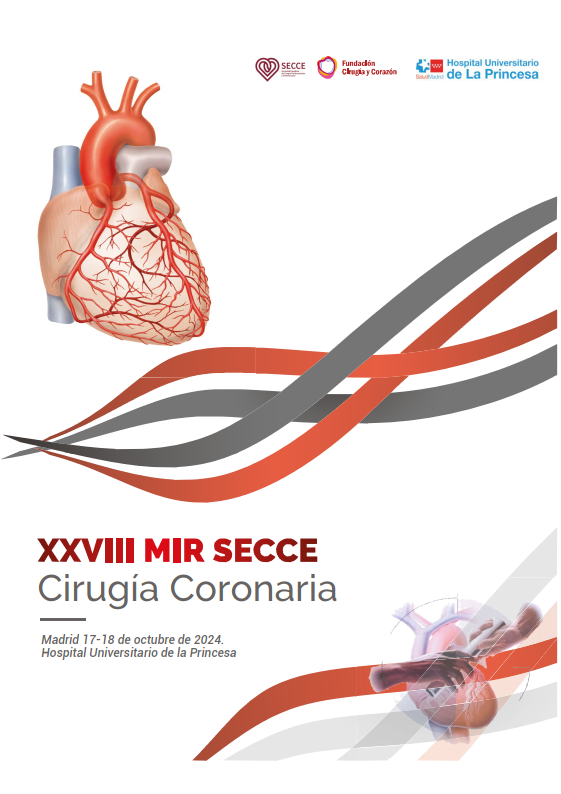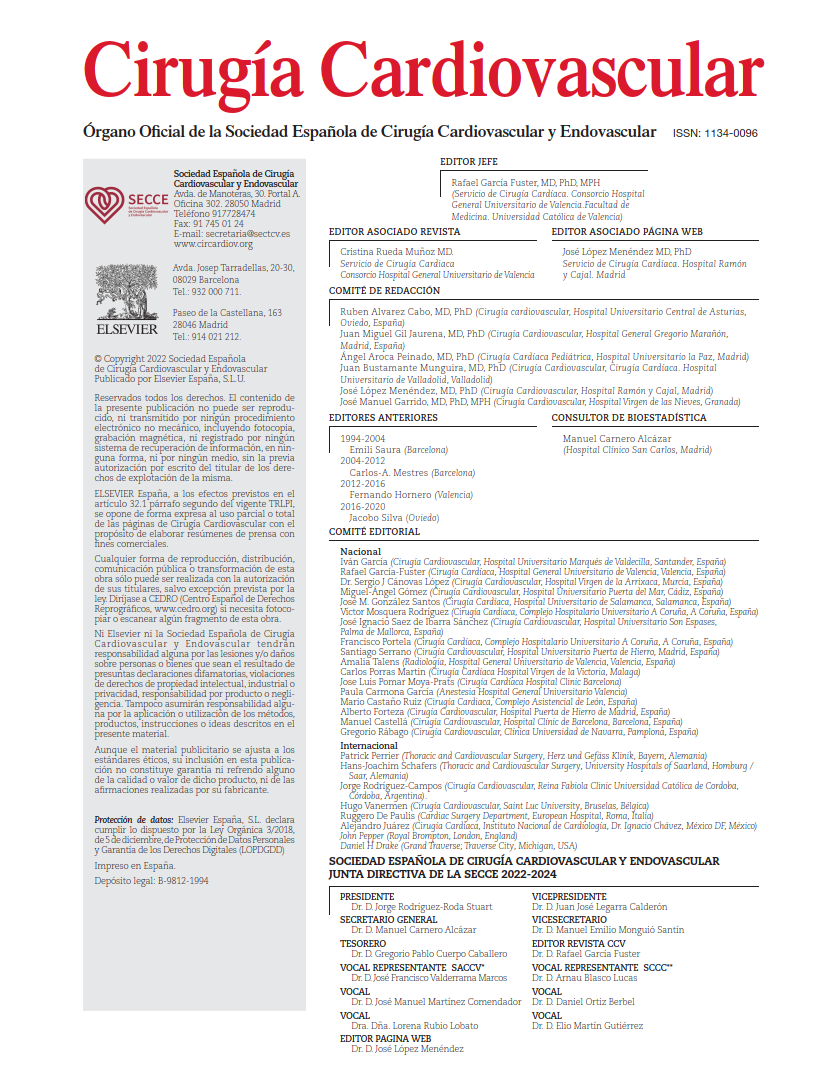Ischemic heart disease involving the unprotected LMCA represents a clinical challenge due to its high mortality in the absence of treatment and the technical complexity of its management. CABG has traditionally been the standard of care, with robust evidence in terms of mortality and major adverse cardiovascular events (MACE). Over recent decades, however, advances in PCI—including new-generation drug-eluting stents, intravascular imaging–guided revascularization, and improved antithrombotic regimens—have supported its role as an alternative strategy in selected patients, particularly those with low anatomic complexity.
Current European guidelines stratify revascularization according to lesion complexity, with CABG carrying a class I, level A recommendation in all scenarios. PCI has a class I, level A recommendation in patients with low SYNTAX scores (0–22), class IIa, level A in those with intermediate scores (23–32), and is contraindicated (class III, level B) in patients with scores >32. Nevertheless, decisions should not rely exclusively on anatomy. The Heart Team must also consider comorbidities, surgical risk, center-specific outcomes, and patient preference. Age is a key determinant, and although it should not be used in isolation, it often influences clinical decision-making. The impact of age on clinical outcomes after revascularization in LMCA disease, however, remains uncertain because of conflicting evidence and the frequent underrepresentation of elderly patients in randomized controlled trials.
In this setting, the recently published meta-analysis by De Filippo et al. addressed this gap by systematically comparing age-stratified outcomes of PCI versus CABG for unprotected LMCA disease.
A total of 14 studies (4 randomized controlled trials and 10 observational studies) were included, all comparing PCI and CABG in patients with unprotected LMCA disease and reporting age-stratified outcomes. End points analyzed during follow-up included all-cause mortality, MACE, myocardial infarction (MI), and repeat revascularization. Random-effects models were applied to account for heterogeneity across study designs. Hazard ratios with 95% confidence intervals were calculated for major outcomes. Cutoffs for defining elderly patients varied from 65 to 80 years. To minimize heterogeneity, sensitivity analyses grouped studies using thresholds of either 65–74 or ≥75 years, allowing exploration of the consistency of results across definitions of elderly age.
Across the 14 studies, a total of 24.767 patients were included (7952 PCI and 16.419 CABG) with a median follow-up of 4.6 years. The median cutoff used to define elderly patients was 72.5 years, while the median ages of the younger and older subgroups were 62 and 80 years, respectively. Baseline characteristics showed that 57% presented with an acute coronary syndrome and 29% had diabetes. Regarding PCI characteristics, a single-stent strategy was used in 39% and intravascular imaging in 31%. In the CABG group, 94% received internal mammary artery grafts and 41% underwent off-pump procedures.
When assessing overall mortality, no significant differences were found between the 2 strategies in elderly patients (p = .95; I2 = 74%), despite high heterogeneity. Sensitivity analyses across different age thresholds yielded consistent results. In younger patients, PCI was associated with higher mortality (p = .002; I2 = 37%), although when observational studies were excluded, no significant differences were observed across age groups. For MACE, no significant differences were observed in younger patients (p = .11), while elderly patients showed a trend toward higher MACE with PCI when the cutoff was set at 65–74 years (p = .06). For MI recurrence, no differences were detected between strategies in either younger (p = .09) or elderly (p = .56) patients. Despite high heterogeneity, PCI was associated with higher rates of repeat revascularization in younger patients (p = .04; I2 = 83%), but no differences were seen among elderly patients (p = .74; I2 = 91%).
Based on these findings, the authors concluded that CABG is associated with lower risk of mortality and repeat revascularization compared with PCI in younger patients, whereas no significant differences exist between strategies in elderly patients.
The authors noted several limitations to consider when interpreting their findings. First, heterogeneity existed in event definitions across studies. Second, elderly patients remained underrepresented. Third, randomized trial populations often differ from real-world cohorts (eg, diabetes prevalence <30%). Fourth, detailed technical information for both PCI and CABG were limited. Finally, the wide time span of included studies (2008–2023) encompassed significant advances in technology and pharmacology. Collectively, these factors warrant caution when extrapolating results to contemporary practice and highlight the need for prospective trials specifically addressing elderly patients.
COMMENTARY:
Age is frequently considered when selecting revascularization strategies for ischemic heart disease, with clinicians often favoring less invasive treatments in elderly patients. However, this population has consistently been underrepresented in studies evaluating PCI versus CABG.
Two landmark studies addressed revascularization in elderly patients with unprotected LMCA disease, both defining elderly as ≥70 years. The 10-year age-stratified analysis of the SYNTAX trial (Ono M et al., J Am Coll Cardiol 2021) found no significant differences in mortality, composite cardiovascular events (MI, stroke, and repeat revascularization), or quality of life among patients ≥70 years undergoing CABG versus PCI for LMCA and/or 3-vessel disease. Conversely, younger patients had significantly better outcomes with CABG, driven by lower MI and repeat revascularization rates compared with PCI. Similarly, the IRIS-Left Main Registry (Park H et al., Am J Cardiol 2019), which included 4000 patients, showed no age-related differences in the composite of death, MI, or stroke, nor in repeat revascularization. The present meta-analysis appears to support the SYNTAX findings, showing no differences between PCI and CABG in patients ≥75 years, while younger patients experienced higher mortality and more repeat revascularizations with PCI. Notably, however, the mortality difference did not persist when only randomized controlled trials were analyzed.
Regarding PCI of the LMCA, advances in intravascular imaging have improved procedural planning and outcome assessment. Studies such as MAIN-COMPARE (Park SJ et al., J Am Coll Cardiol 2008) with intravascular ultrasound (IVUS) and ILUMEN (Kim BK et al., JACC Cardiovasc Interv 2023) with optical coherence tomography (OCT) support the technical and clinical benefits of imaging-guided PCI for LMCA disease. Nevertheless, most comparative studies, including those in this meta-analysis, did not consistently use imaging, which limits generalizability to current practice. Future trials incorporating contemporary standards of both PCI and CABG will be essential to refine optimal treatment strategies.
Based on this meta-analysis, age should be considered in Heart Team discussions. Current evidence suggests CABG may be favored in patients <70–75 years, given lower risks of MI and repeat revascularization, whereas PCI may be reasonable in older patients. Importantly, age should not be interpreted in isolation but integrated with structured assessments of frailty, quality of life, anatomic complexity, surgical risk scores, institutional expertise, and, crucially, patient preference. Thus, age should be viewed as one of several complementary factors guiding individualized decision-making.
REFERENCE:
De Filippo O, Di Franco A, Improta R, Di Pietro G, Leone A, Pecoraro M, et al. Percutaneous coronary intervention versus coronary artery bypass grafting for left main disease according to age: A meta-analysis. J Thorac Cardiovasc Surg. 2025;170(1):232–243. https://doi.org/10.1016/j.jtcvs.2024.07.039



